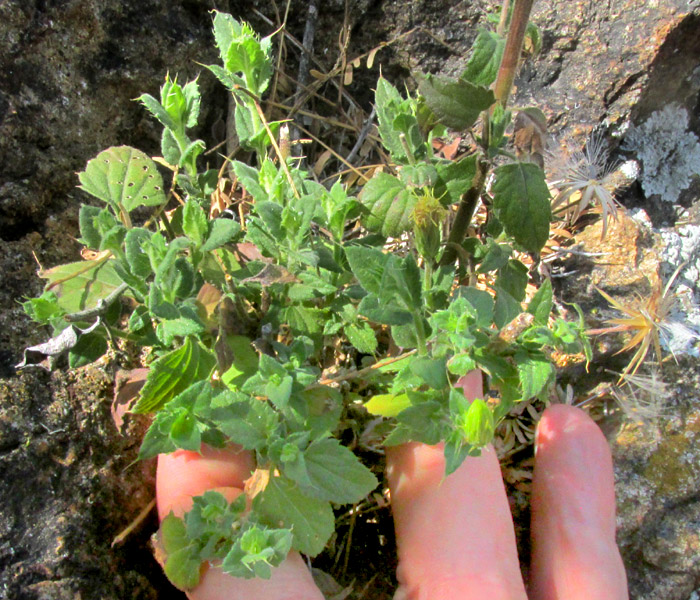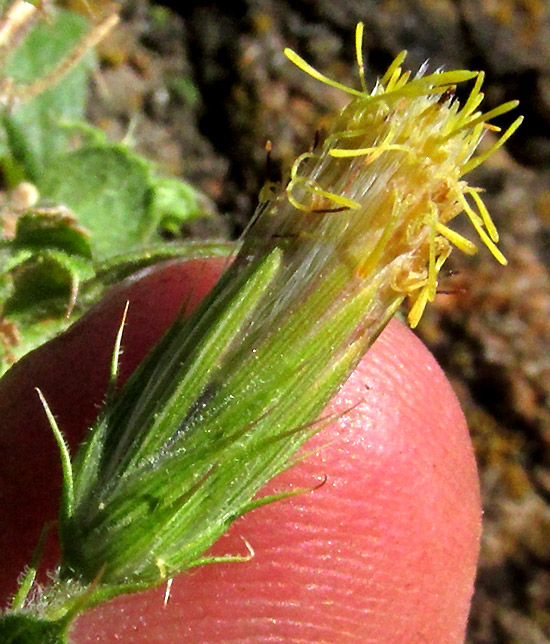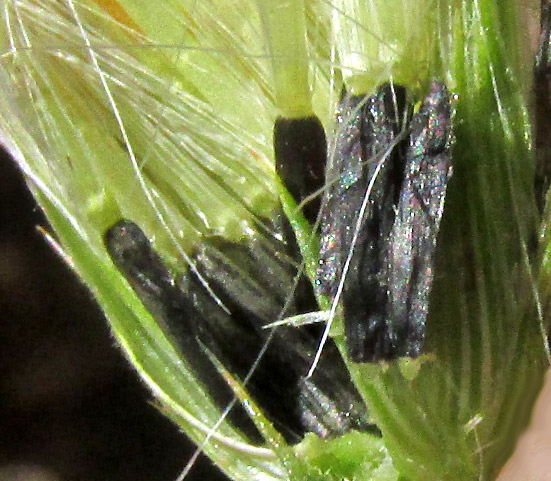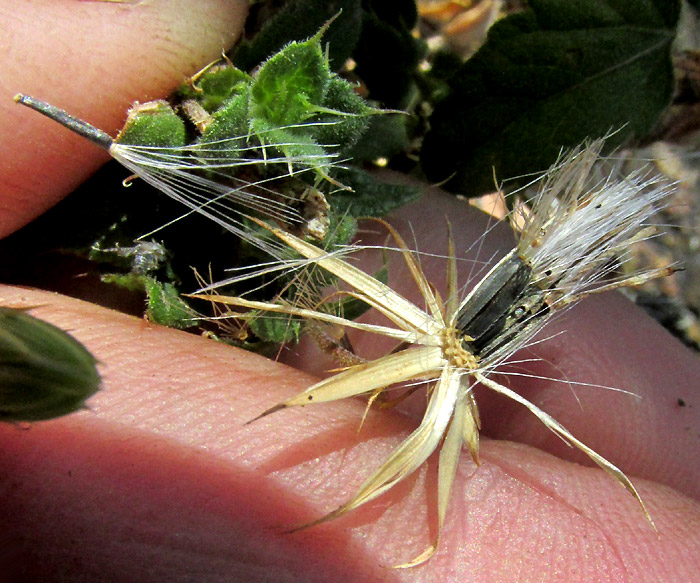Excerpts from Jim Conrad's
Naturalist Newsletter
Entry dated March 7, 2024, from notes taken about 2kms south of Higuerillas, Municipality of Cadereyta de Montes; N20.8872°, W99.7718°, elevation ~1660 meters (~5450 feet); bedrock of volcanic rhyolite; local narrow belt of vegetation constituting an extreme southern extension of the Chihuahuan Desert, Meridional Subregion; central Querétaro state, MÉXICO
BRICKELLIA SUBULIGERA

The above little bush had been cropped by roving feral burros and cattle but in a hard-to-reach spot on a steep cliff wall of rhyolite it still managed to flower and fruit. Well camouflaged a little right of center in the photo there's a greenish flowering head, and on the plant's right side there are remnants of last season's flowering heads whose fruits already have been disseminated by the wind.

With numerous florets crammed into a greenish, bowl-shaped involucre, it's clear that our plant is a member of the largest of all plant families, the Composite/Aster/Sunflower Family, the Asteraceae. The slender, yellow items are style branches with hard-to-see stigmatic areas where pollen lands, pollinating the floret. At the bottom of each floret, not seen above, one style arises atop each ovary, producing two branches. In this flowering head, or capitulum, no ray-florets with flat, petal-like corollas are produced; there are only cylindrical disc florets. Later I was to read that this species' corollas are white, but in the picture they aren't visible. Among the disc floret corollas are many slender, white bristles, which constitute the pappuses atop the ovaries, surrounding the corollas' bases; later they will form white "parachutes" for fruit dispersal, as with mature dandelion flowers.

Enveloping the florets, the green involucre composed of several slender scales, or phyllaries, displays valuable field marks for identification. The phyllaries are of different lengths and overlapping one another. They're needle-tipped, and each is longitudinally striated with alternating lighter and darker green lines. The lower ones bend away from the involucre.

Above, a dissected, more mature capitulum reveals that the black, cypsela-type fruits are not separated from one another by scale-like paleae. That helps define the genus, and the number and disposition of longitudinal ridges on the cypselae help with determining the species.

In this species, when the capitula mature and are ready for wind dispersal, the phyllaries spread out and backwards. When the cypselae are disseminated, the star-bursts of spreading phyllaries remain conspicuously present for weeks.

Leaves are strongly 3-veined from their bases, and densely short-hairy. The needle-like bristles at the tip of most blade teeth are very distinctive.
All the above features lead us to the genus Brickellia, home to maybe 100 species, of which around 78 are native to Mexico, which is the genus's center of diversity. Seventeen Brickellia species have been documented for the adjacent state of Guanajuato, so here in Querétaro a similar number likely can be found. In our area, a commonly occurring and similar species is Brickellia veronicifolia, whose leaf margins lack needle-tipped teeth, and whose cypselae are brown, not black. These differences lead us to BRICKELLIA SUBULIGERA, with no English name, though all Brickellia species can be called Bricklebushes.
Brickellia subuligera occurs in warmer, dry environments, especially disturbed ones, throughout Mexico from the northern states south to Oaxaca. I read that, at least when not cropped by wandering herbivores, the plants grow into perennial shrubs up to 1m high (3.3ft).
Though I find no traditional medicinal uses of Brickellia subuligera -- possibly because the species is so hard to distinguish from others of the genus -- traditionally some species have been used therapeutically. The 2014 study by Etetor Eshiet and others entitled "Chemical characterization of Brickellia cavanillesii (Asteraceae) using gas chromatographic methods," tells us that "As an intervention, Brickellia is traditionally consumed as an herbal tea for its presumed antiulcer, antimigraine, cardiotonic, and antidiabetic properties among others."
The 2015 study by Edward Schilling and others entitled "Bricklebush (Brickellia) phylogeny reveals dimensions of the great Asteraceae radiation in Mexico," found that the ancestral taxon of genus Brickellia emerged about nine million years ago, which was the late Miocene Epoch. The Miocene was a time of global drying and cooling, when many plant and animal groups died out, but were replaced by taxa adapted to a drying world. The Aster Family is estimated to have arisen in the late Cretaceous about 83 million years ago, so Bricklebush species can be thought of as a relatively recently evolved kind of plant, with "modern" adaptations.